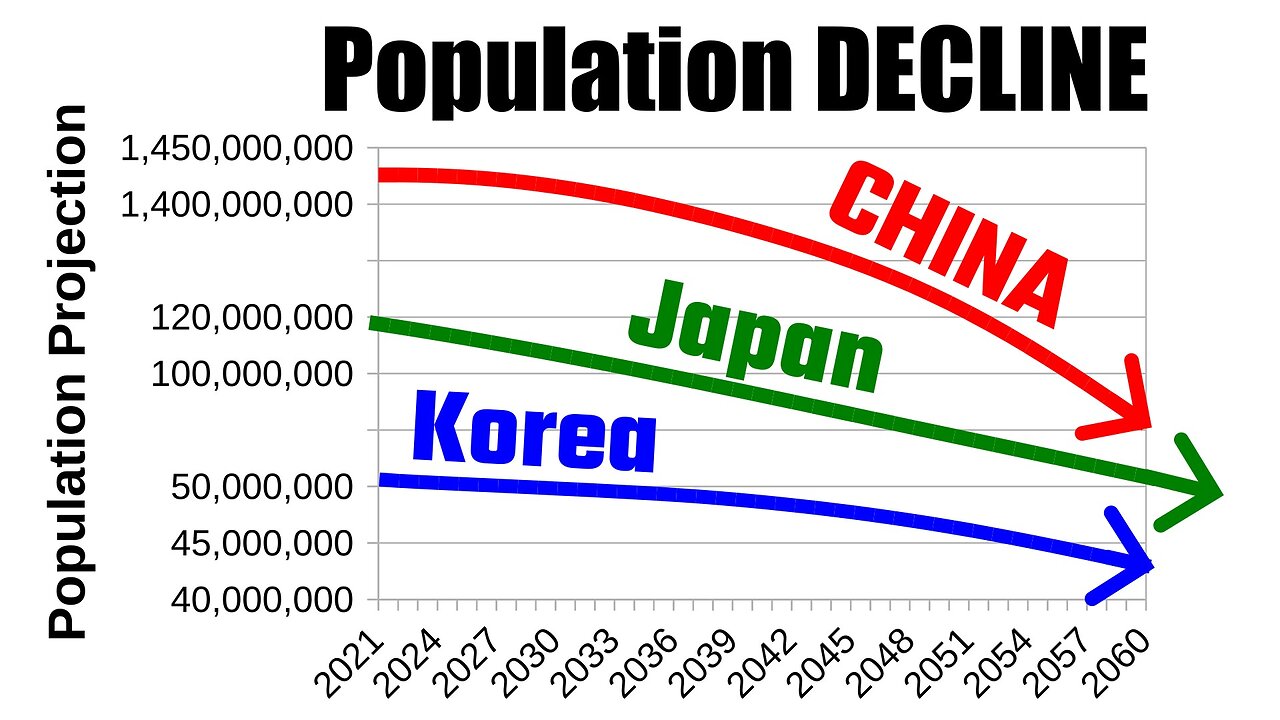Premium Only Content

World’s Fertility Rate in Free Fall
The world’s fertility rate is falling, and has been for a long time. In the 1960s, it peaked at around 5.3, and most recently sits at around 2.3 in 2020. On average, ladies have been having fewer babies. According to the OECD, the replacement fertility rate is roughly 2.1 children per woman, which is where the population exactly replaces itself from one generation to the next, that is, without migration. Rates greater than 2.1 result in population growth, whereas rates lower than 2.1, so called sub-replacement fertility, result in (eventual) population decline. Although the world is currently at 2.3, meaning that the world’s population is growing, many nations are now experiencing sub-replacement fertility, especially in Asia, which is resulting in massive social ramifications. And that’s what we’ll be talking about in this video.
Looking at the world map, in many advanced economies, the fertility rate is below replacement. Australia: 1.58, New Zealand: 1.61; United States: 1.64, Canada: 1.4, UK: 1.56, Russia: 1.5. In Asia, especially East Asia, things are looking pretty bleak. Japan: 1.34, China: 1.28, and Korea: 0.84. Mothers are barely having a single child. Higher fertility rates only really remain in parts of Sub-Saharan Africa, such as Niger at 6.89, some parts of the Middle East, for example, Iraq at 3.55, and some Central Asian countries such as Afghanistan at 4.75. But many, many countries, shown in the lightest shade of blue, are now experiencing fertility declines.
Now let’s look at the OECD’s Stat website, specifically, Demography and Population, Population Statistics, and then Population Projections. I’ll be customising by Time, clicking on “latest available data”, and then clicking View Data. This will provide projections all the way up to 2060. I’ll just be exporting data for some countries. For example, here’s Australia’s population projections. It’s definitely heading upwards, not because of fertility rate, which was below replacement at 1.58, but because of immigration. Most of these Western nations rely on immigration to fuel their populations. New Zealand are also projected to increase in population over the next few decades. Similarly, the United States population is headed upwards thanks to immigration, as is Canada’s, which has a fairly low fertility rate at 1.4. I can only assume that immigration plays a large part in Canada’s increasing population, and the UK is following similar trends, although the UK is expected to peak around the mid to late 2050s. I’m not sure why. Perhaps due to limitations in land area? It simply cannot sustain a higher population. Either way, Western nations with low fertility rates are continuing their immigration policies, I assume largely out of necessity to support an older population and labour force growth, as well as economic development.
But if we look at Asian countries, things are a lot different. For example, Russia (I know, it’s also considered part of the European continent), has a declining population now, significantly so. Russians are not having enough babies, and nobody is moving to Russia. Is this a path to self-destruction? I don’t know. Japan, famous for overwork, is also facing significant population declines. According to a recent SBS News article, “it's on the cusp of being unable to function”. It’s “now or never” for one of the world’s oldest societies to take action to arrest its shrinking population, Japan’s Prime Minister Fumio Kishida says. They’re resorting to paying people to have babies, but even that isn’t working. It requires societal change. China, with an even lower fertility rate is now facing population declines as well. Their one-child-policy changed society forever. Even though they’ve since removed that policy, society has already been set up for single-child families. Nobody wants more than one child anymore. The government have permanently changed society. The world’s most populous nation no more! And finally, South Korea. It is a disaster waiting to happen. With the world’s lowest fertility rate, what will become of South Korea? I don’t know. News reports are suggesting that South Korea’s pension fund is going to run out by 2055. Low births and an ageing population will spell disaster.
None of this is suggesting that I think population growth at all costs is good, far from it, but East Asian populations are facing somewhat of a reckoning. Birth rates have plummeted and now these countries are facing almost irreversible population declines that will potentially bring turmoil to these ancient societies.
MUSIC
Allégro by Emmit Fenn
-
 4:14
4:14
Daily Insight
1 month agoLabor’s Awful Misinfo Bill Rightfully Quashed
88 -
 5:42:36
5:42:36
FreshandFit
15 hours agoLive X Censorship For Opposing Immigration?!
157K95 -
 1:08:16
1:08:16
Tactical Advisor
11 hours agoNEW Budget Glocks | Vault Room Live Stream 011
70.7K6 -
 16:30
16:30
SNEAKO
18 hours agoNO FRIENDS IN THE INDUSTRY.
103K40 -
 6:19
6:19
BlackDiamondGunsandGear
1 day agoHow Fat Guys can Appendix Carry
80.6K10 -
 6:58
6:58
Gun Owners Of America
1 day ago2024 Was Huge For Gun Rights, Here's Our Top 10 Wins!
65.9K6 -
 15:50
15:50
Degenerate Jay
1 day ago $2.57 earnedJames Bond Is Being Ruined By Amazon? Make Him A Black Gay Woman?
44.2K11 -
 15:18
15:18
DeVory Darkins
1 day ago $20.94 earnedTrump Drops NIGHTMARE Warning on Joe Biden
64.4K106 -
 36:13
36:13
The Why Files
1 month agoAlien Implants Vol. 1: Devil’s Den UFO Encounter: What Was Found Inside Terry Lovelace?
86.6K41 -
 9:03
9:03
Alabama Arsenal
2 days ago $0.97 earnedAAC HUB 2K | Modern Features, Iconic Classic Looks
22.6K1